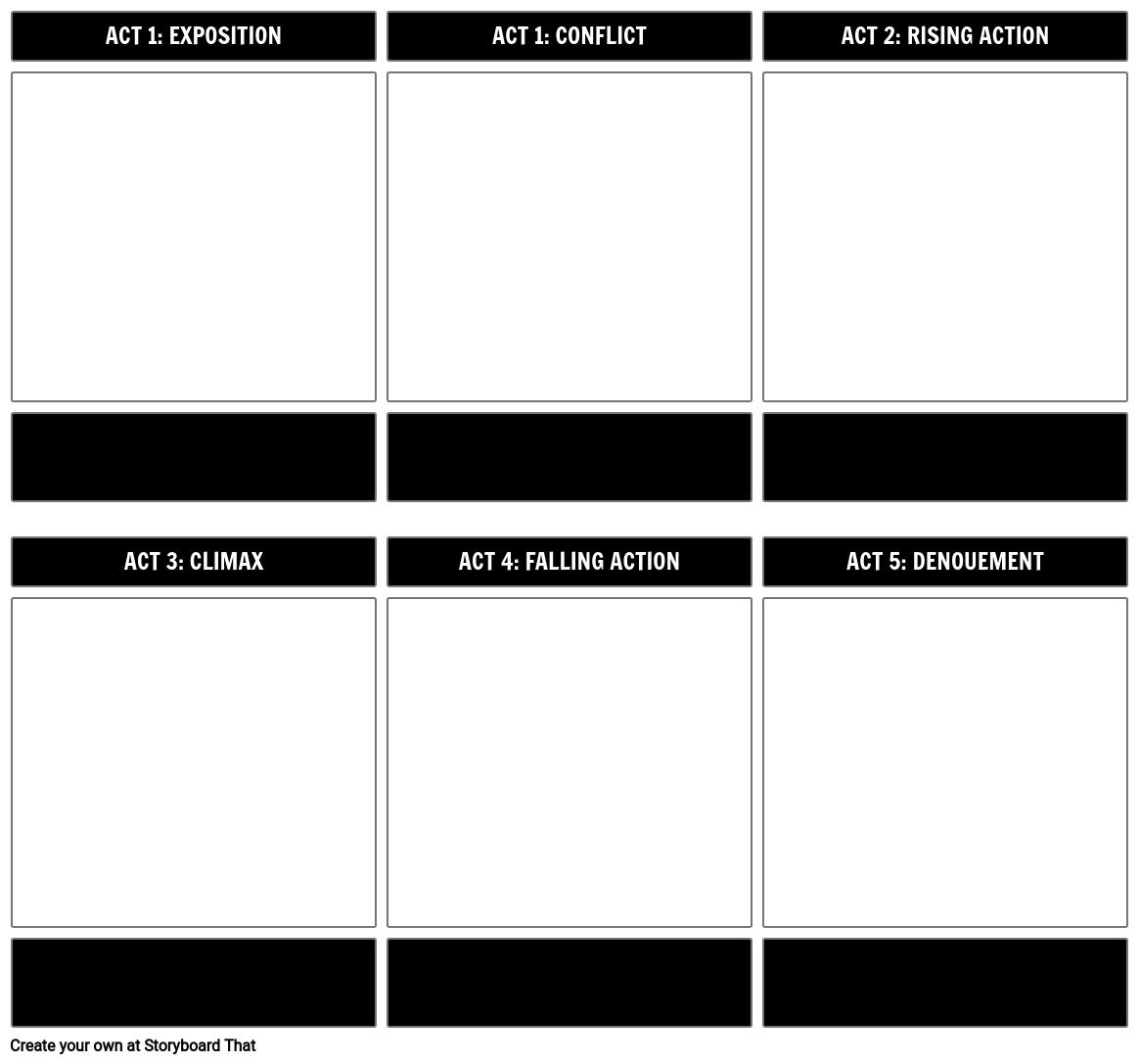https://www.storyboardthat.com/lesson-plans/death-of-a-salesman-by-arthur-miller/five-act-structure
Activity Overview
With Storyboard That, students can diagram a play’s five act structure to show the sequence of events. Not only is this a great way to teach the parts of plot, but it reinforces major actions from the play and helps students develop greater understanding for literary structures. For each cell, have students create a scene that follows the acts in order: Prologue, Conflict, Rising Action, Climax, Falling Action, and Denouement / Epilogue.
Template and Class Instructions
(These instructions are completely customizable. After clicking "Copy Activity", update the instructions on the Edit Tab of the assignment.)
Student Instructions
Create a visual plot diagram of Death of a Salesman.
- Separate the play into the Prologue/Exposition, Rising Action, Climax, Falling Action, and Denouement.
- Create an image that represents an important moment or set of events for each of the acts.
- Write a description of each of the steps in the plot diagram.
Lesson Plan Reference
Common Core Standards
- [ELA-Literacy/RL/9-10/2] Determine a theme or central idea of a text and analyze in detail its development over the course of the text, including how it emerges and is shaped and refined by specific details; provide an objective summary of the text
- [ELA-Literacy/RL/9-10/3] Analyze how complex characters (e.g., those with multiple or conflicting motivations) develop over the course of a text, interact with other characters, and advance the plot or develop the theme
- [ELA-Literacy/RL/9-10/5] Analyze how an author’s choices concerning how to structure a text, order events within it (e.g., parallel plots), and manipulate time (e.g., pacing, flashbacks) create such effects as mystery, tension, or surprise
Rubric
(You can also create your own on Quick Rubric.)
Five Act Structure Rubric (Grades 9-12)
Create a plot diagram for the play using Prologue/Exposition, Conflict, Rising Action, Climax, Falling Action, and Resolution.
| Proficient | Emerging | Beginning | Try Again | |
|---|---|---|---|---|
| Descriptive and Visual Elements | Cells have many descriptive elements, and provide the reader with a vivid representation. | Cells have many descriptive elements, but flow of cells may have been hard to understand. | Cells have few descriptive elements, or have visuals that make the work confusing. | Cells have few or no descriptive elements. |
| Grammar/Spelling | Textables have three or fewer spelling/grammar errors. | Textables have four or fewer spelling/grammar errors. | Textables have five or fewer spelling/grammar errors. | Textables have six or more spelling/grammar errors. |
| Evidence of Effort | Work is well written and carefully thought out. Student has done both peer and teacher editing. | Work is well written and carefully thought out. Student has either teacher or peer editing, but not both. | Student has done neither peer, nor teacher editing. | Work shows no evidence of any effort. |
| Plot | All parts of the plot are included in the diagram. | All parts of the plot are included in the diagram, but one or more is confusing. | Parts of the plot are missing from the diagram, and/or some aspects of the diagram make the plot difficult to follow. | Almost all of the parts of the plot are missing from the diagram, and/or some aspects of the diagram make the plot very difficult to follow. |
More Storyboard That Activities
Death of a Salesman
This Activity is Part of Many Teacher Guides
*(This Will Start a 2-Week Free Trial - No Credit Card Needed)
https://www.storyboardthat.com/lesson-plans/death-of-a-salesman-by-arthur-miller/five-act-structure
© 2024 - Clever Prototypes, LLC - All rights reserved.
StoryboardThat is a trademark of Clever Prototypes, LLC, and Registered in U.S. Patent and Trademark Office
© 2024 - Clever Prototypes, LLC - All rights reserved.
StoryboardThat is a trademark of Clever Prototypes, LLC, and Registered in U.S. Patent and Trademark Office












